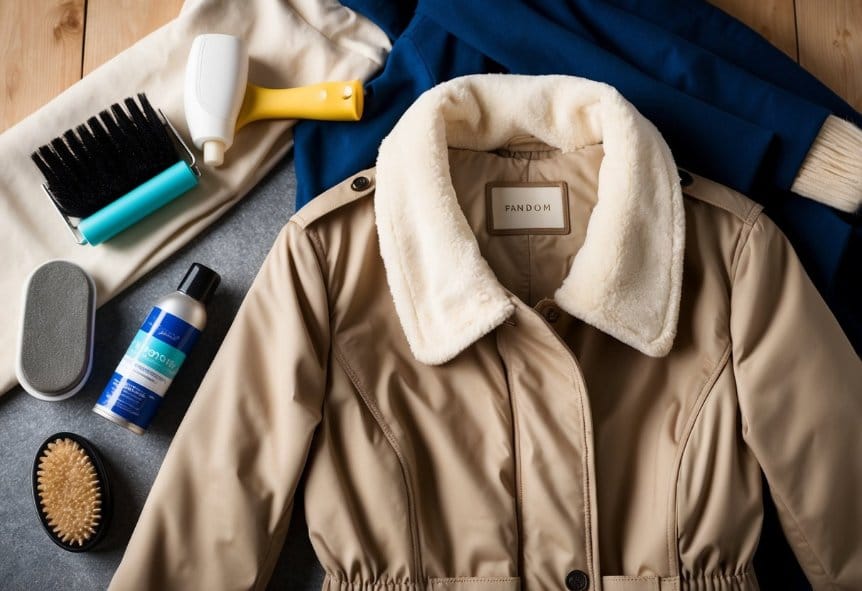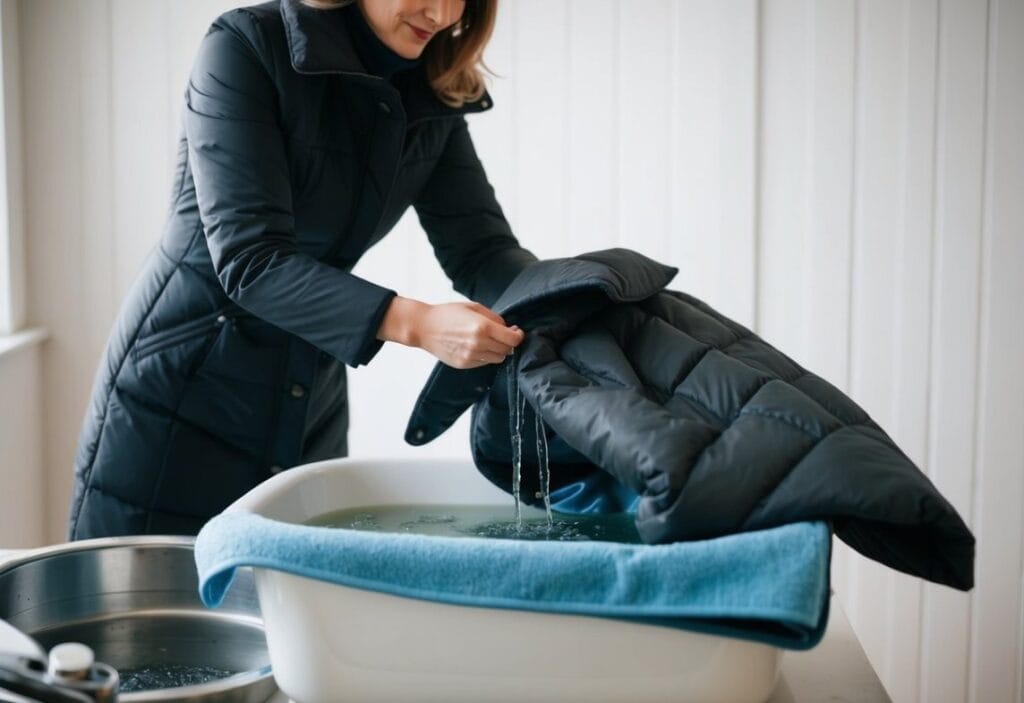Winter coats are essential for staying warm and stylish during the cold months. As someone who loves fashion and practicality, I’ve learned a lot about caring for these important pieces. Proper care and cleaning of winter coats can extend their life and keep them looking great year after year.
Taking care of winter coats isn’t hard, but it does require some know-how. Different materials need different types of care. For example, wool coats often need dry cleaning, while many synthetic puffer jackets can be washed at home. I always check the care label first to make sure I’m using the right method.
Regular upkeep is key to keeping coats in good shape. I brush off dirt and spot clean small stains right away. For storage, I use hangers that support the shoulders and keep coats in a cool, dry place. These simple steps help my coats last longer and look better.
Table of Contents
Key Takeaways
- Check care labels and use the right cleaning method for each coat
- Spot clean stains quickly and brush off dirt regularly
- Store coats properly using good hangers in a cool, dry place
Understanding Winter Coat Materials

Winter coats come in many types of fabrics and materials. Each requires specific care to keep it looking great. Let’s look at how to identify coat types and choose the right cleaning products.
Identifying Coat Types
I look at the coat’s label to see what it’s made of. Wool coats are warm but need gentle care. Down jackets have feather filling that can clump if washed wrong. Synthetic coats often use polyester fill that’s easier to clean. Some coats mix materials, like a wool shell with synthetic lining.
I check for special features too. Water-resistant coats have special coatings. Fur trim needs extra care. Knowing the materials helps me clean my coat the right way.
Choosing the Right Detergent and Additives
I use mild or gentle detergent for most winter coats. Regular detergents can be too harsh. For wool, I pick a detergent made for delicates. Down jackets need special down-safe soap.
I avoid fabric softener on technical coats. It can ruin their water resistance. For puffy coats, I use dryer balls to keep the fill fluffy. They work better than dryer sheets.
Some coats need dry cleaning only. I always follow the care label instructions to keep my coat in top shape.
Cleaning and Washing Techniques

Proper cleaning keeps winter coats looking great and lasting longer. I’ll cover key steps for both hand washing and machine washing women’s coats.
Hand Washing Tips
I recommend hand washing delicate coats or those with special trims. Fill a sink with cool water and add a mild detergent. Gently submerge the coat and swish it around. Don’t twist or wring the fabric. For stains, I dab a bit of stain remover on the spot before washing.
After a few minutes of soaking, I drain the soapy water and refill with clean cool water to rinse. I repeat rinsing until the water runs clear. To dry, I press out excess water without twisting. Then I lay the coat flat on a clean towel.
Machine Wash Best Practices
For machine-washable coats, I always check the care label first. I zip up zippers and fasten buttons to prevent snags. I turn the coat inside out and put it in a mesh laundry bag for extra protection.
I choose the gentle cycle and cold water. Hot water can damage coats or cause shrinkage. I use a small amount of mild detergent made for delicates. I skip fabric softener, which can harm waterproofing.
After washing, I reshape the coat and lay it flat to air dry. I avoid putting coats in the dryer, as heat can ruin the fabric and insulation. For puffy coats, I toss in a few dryer balls during the spin cycle to help fluff the filling.
Professional Care and Dry Cleaning

Professional cleaning can extend the life of your winter coat. I’ll cover when to seek expert care and how to maintain coats between cleanings.
When to Choose Professional Cleaning
I recommend professional cleaning for wool coats at least once a season. Dry cleaning is best for delicate fabrics like cashmere and silk. It’s also ideal for coats with special trims or linings.
Look for these signs that your coat needs professional care: • Visible stains or odors • Dull or matted fabric • Loose buttons or damaged closures
Many dry cleaners offer specialized services for winter coats. They can re-waterproof your coat and repair minor damage. Always point out stains or issues when dropping off your coat.
Maintaining Coats Between Cleanings
I brush my wool coats after each wear to remove dirt and debris. This keeps the fabric looking fresh longer. For other coats, I use a lint roller or tape to pick up dust and hair.
Spot cleaning is helpful for small stains:
- Blot (don’t rub) the stain with a clean white cloth
- Use a gentle soap solution for most fabrics
- Rinse with a damp cloth and air dry
I hang coats on sturdy padded hangers to keep their shape. Avoid cramming coats in closets. Let them air out after wearing to prevent odors.
For storage, I use breathable garment bags in a cool, dry place. This protects coats from dust and moths between seasons.
Maintaining Coat Quality and Performance

Proper care keeps winter coats looking good and working well. I’ll cover daily upkeep and storage tips to extend the life of your coat.
Daily Care Techniques
I brush my wool coats after each wear with a soft clothing brush. This removes dirt and debris before they can settle in. For other fabrics, I use a lint roller. I spot clean small stains right away with a damp cloth. To prevent odors, I air out my coat after wearing it. I hang it on a sturdy hanger away from heat sources.
For performance outerwear, I follow the care label. I wash my technical jackets in cold water with special detergent. I use a front-loading washer on gentle cycle. I avoid fabric softeners, which can harm waterproofing. I air dry or tumble dry on low heat.
Seasonal Storage Solutions
I clean my coats before storing them for summer. For washable coats, I use the gentlest method – hand washing or machine washing on delicate. I let them dry fully before storage.
I store my coats in a cool, dry, dark place. I use breathable garment bags for delicate fabrics. For puffy coats, I use vacuum storage bags to save space. I add cedar blocks to deter moths. I fold knit coats to prevent stretching. I hang structured coats on padded hangers. I check my stored coats every few months for issues.
Additional Tips for Specific Coat Types

Different winter coat styles need special care. I’ll go over key tips for fleece, puffers, parkas, and insulated layers to keep them in top shape.
Fleece Jackets and Puffer Vests
For fleece jackets, I wash them in cold water with mild detergent. I turn them inside out first to protect the outer surface. I avoid fabric softeners, as they can ruin the fleece’s texture.
With puffer vests, I’m extra careful. I use the gentle cycle and add a couple of tennis balls to the dryer. This helps fluff up the filling.
I always check care labels. Some fleece and puffers need hand washing. For those, I use a sink with cool water and gentle soap. I rinse well and squeeze out excess water without twisting.
Handling Parkas and Insulated Layers
Parkas often have special coatings or materials. I spot clean them when possible to avoid washing too often. For deeper cleaning, I use a front-loading washer on gentle.
I remove any fur trim before washing. Fur needs separate care – usually dry cleaning or gentle brushing.
For down-filled coats, I’m extra careful. I use a down-specific detergent and dry on low heat. I check every 20 minutes to break up clumps.
With synthetic insulation, I follow the care label closely. Most can be machine washed, but I always use cool water and a gentle cycle.

